
Introduction
Welcome to the June 2022 Apartment List National Rent Report. Rent growth accelerated slightly again this month, with our national index up by 1.2 percent over the course of May. So far this year, rents are growing more slowly than they did in 2021, but faster than the growth we observed in the years immediately preceding the pandemic. Over the first five months of 2022, rents have increased by a total of 3.9 percent, compared to an increase of 6.1 percent over the same months of 2021. Year-over-year rent growth currently stands at a staggering 15.3 percent, but is down slightly from a peak of 17.8 percent at the start of the year.
On the supply side, our national vacancy index ticked up slightly again this month, continuing a streak of gradual easing dating back to last fall. Our vacancy index now stands at 5 percent, up from a low of 4.1 percent, but remains well below the pre-pandemic norm. Rents increased this month in 96 of the nation’s 100 largest cities, though 70 of these cities have seen slower rent growth in 2022 so far than they did last year, and some of the hottest Sun Belt markets are finally showing signs of plateauing growth.
Month-over-month rent growth accelerates with 1.2% increase; up 15.3% year-over-year
After a brief seasonal dip to close out 2021, rents have been steadily rising throughout 2022, with the pace of growth increasing each month so far this year. Our national rent index increased by 1.2 percent month-over-month in May, the largest monthly increase of the year. Despite the steady increases, the pace of growth has slowed down significantly compared to last year. In May 2021, our national rent index jumped by 2.2 percent month-over-month, setting a record that would subsequently be broken in the following months. In contrast, this month’s increase is closer to the rates we observed in the years preceding the pandemic – from 2017 to 2019, month-over-month growth in April averaged 1 percent, just a bit below this month’s 1.2 percent increase.
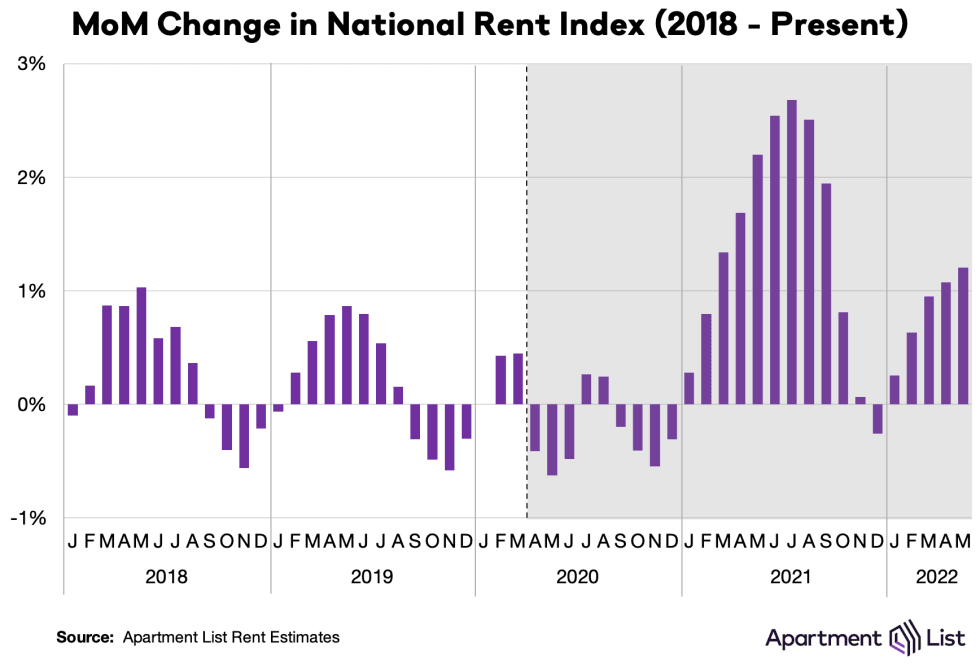
This trend has held consistent for the entirety of 2022; namely, that rent growth is trending well behind last summer’s scorching pace, but ahead of the pre-pandemic norm. From January through May in each of the past 5 years, rents grew by 3.0 percent in 2018, 2.5 percent in 2019, -0.2 percent in 2020, 6.1 percent in 2021, and 3.9 percent in 2022.
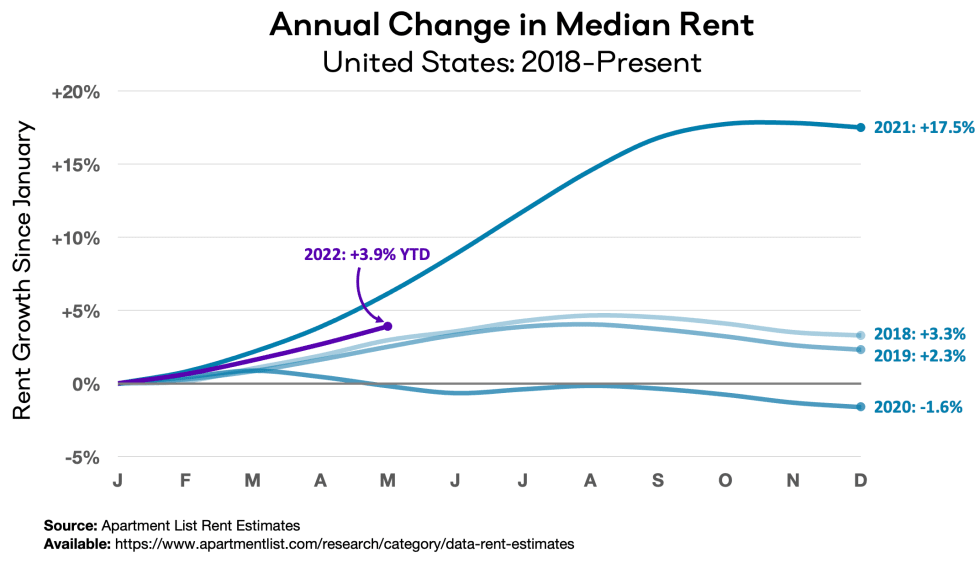
Over the past 12 months as a whole, rent prices have spiked by an unprecedented 15.3 percent nationally. Rent growth over the past year has far outpaced that of any prior year in our estimates, which go back to 2017. For comparison, year-over-year rent growth in May averaged just 2.4 percent in 2018-2019. That said, our year-over-year growth estimate has been gradually cooling in recent months after peaking at 17.8 percent in January, as monthly growth comes in slower than last year’s pace. Based on what we’ve seen so far this year, rent growth in 2022 seems likely to continue exceeding the pre-pandemic trend, even as it moderates substantially from 2021 levels.
Vacancy remains low entering the rental busy season
As we’ve explored in detail, much of the 2021 rent boom was attributed to a tight market in which more households were competing for fewer vacant units. Our vacancy index spiked above 7 percent in the early months of the pandemic in 2020, as many Americans moved in with family or friends amid the uncertainty and economic disruption of the pandemic’s onset. After that, however, vacancies began a steady decline, eventually falling to a low of 4.1 percent.
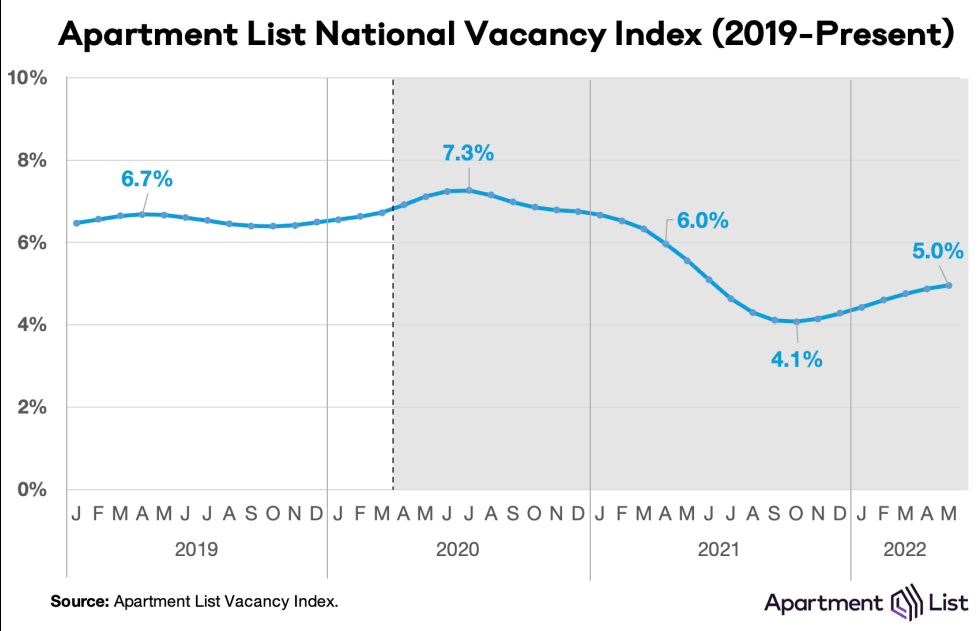
After bottoming out at 4.1 percent last October, our vacancy index has now gradually ticked back up for seven consecutive months, hitting 5 percent in May. Although this gradual easing in occupancy is a positive signal, the market remains historically tight. And although we’re now at the start of the busy season for the rental market, when the bulk of moving activity normally takes place, rapidly rising rents may incentivize many renters to stay put and renew existing leases rather than looking for new ones. At the same time, the recent spike and mortgage rates has created yet another barrier to a historically difficult for-sale market, potentially sidelining would-be homebuyers and keeping them in the rental market. Given these factors, it’s possible that the easing of our vacancy index could level off in the coming months.
Rents up month-over-month in 96 of 100 largest cities
If 2020 was characterized by price convergence (expensive cities getting cheaper and cheaper cities getting more expensive), 2021 was characterized by price inflation: cities large and small getting more expensive, rapidly. This can be seen in the chart below, which visualizes monthly rent changes in each of the nation’s 100 largest cities from January 2018 to present. The color in each cell represents the extent to which prices went up (red) or down (blue) in a given city in a given month. The band of dark red in 2021 depicts last year’s rent heatwave, which peaked in July and August 2021 when all 100 cities in this chart saw prices go up. Meanwhile, the rightmost columns show rent growth falling back to more reasonable levels starting last fall. In December 2021, rents actually fell in 61 of the nation’s 100 largest cities, the only month last year in which more than half of these cities saw a decline. This month, however, rents were up in 96 of the nation’s 100 largest cities.
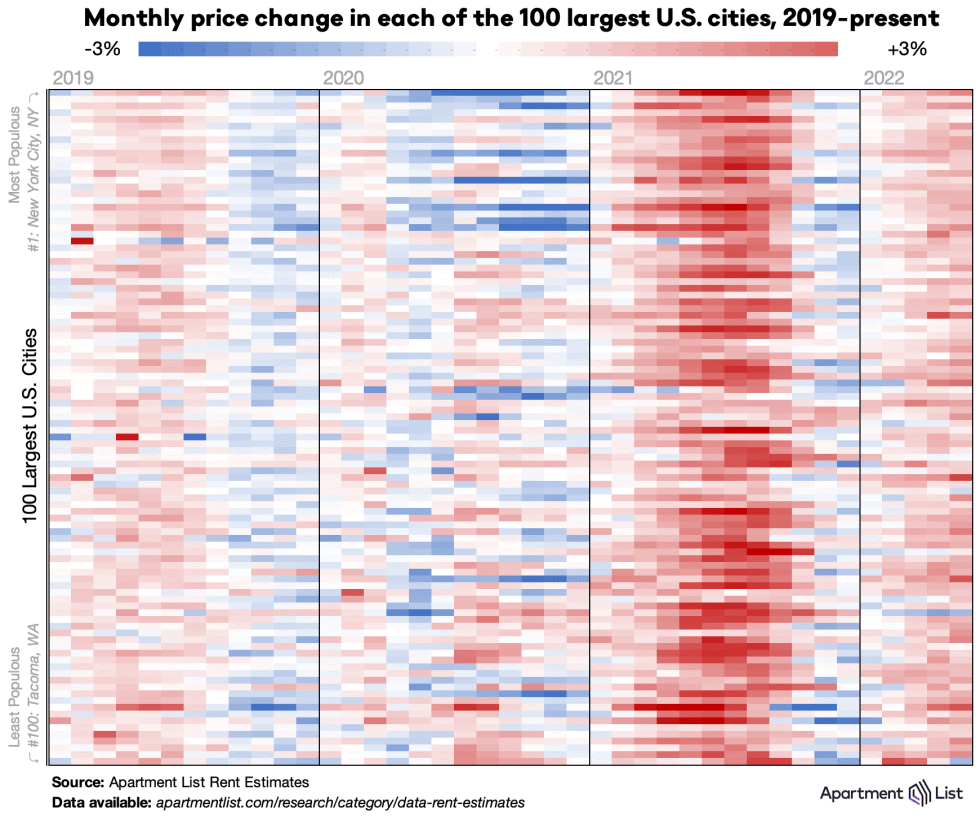
Despite rents increasing nearly across the board this month, a slowdown in the pace of growth is also widespread. 70 of these 100 have experienced slower rent growth in the first five months of 2022 than they did over the same months of 2021. And in a small handful of these cities, rents are currently lower than they were at the start of the year. Most notably, rents in Scottsdale, AZ have fallen by 5.7 percent so far in 2022, exemplifying a broader cooldown in the Phoenix metro which we explore further below.
Miami and Orlando continuing to boom
Major markets throughout the Sun Belt have experienced virtually-uninterrupted rent growth since the start of the pandemic. The following table shows the ten metropolitan areas that have experienced the fastest rent growth over the past six months, over the past year, and since the pandemic started in March 2020:
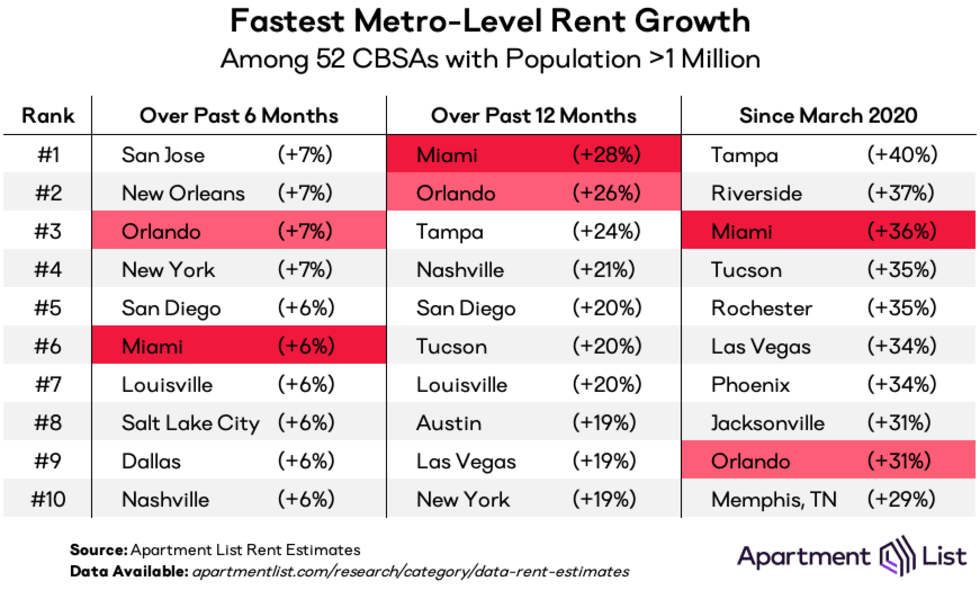
The Miami metro has seen the nation’s fastest growth over the past year (+28 percent), nearly doubling the growth rate of our national index over that period. The Miami metro also ranks #6 for rent growth over the past six months, and #3 for growth over the entire pandemic since March 2020. Orlando is the only other metro to land in the top 10 across all three of these time horizons. The Tampa metro has had the fastest rent growth over the course of the pandemic as a whole, with a staggering 41 percent increase. However, growth in Tampa has cooled down in recent months, with a more modest 2.7 percent increase since last October, which is actually slower than the national average. As we see below, other fast-growing metros have experienced even sharper cooldowns in recent months. On the other hand, we’ve also seen some metros heating up in recent months which had not been among the hottest markets in the earlier phases of the pandemic – the San Jose, New Orleans, Louisville, Salt Lake City, and Dallas metros each appear in the top ten in only the six-month column.
Only the San Francisco Bay Area still lags pre-pandemic rent levels (barely)
At the other end of the spectrum, a number of markets have seen much more modest rent growth since the start of the pandemic. These are generally a mix of pricey coastal metros, where rents fell sharply in 2020 followed by a rebound last year, and Rust Belt metros, where growth has consistently been sluggish compared to the national average. The table below is analogous to the one above, but shows the metros where rent growth has been slowest:
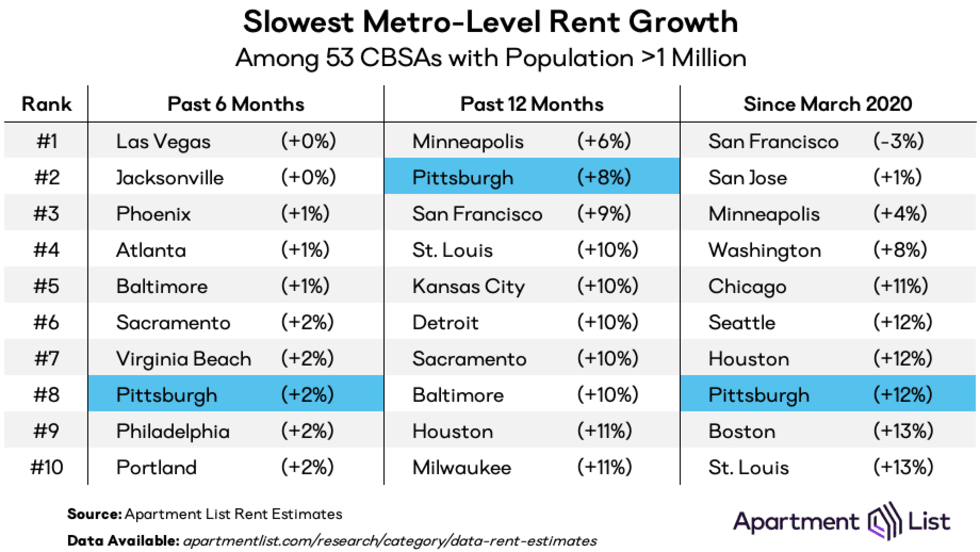
In the San Francisco metro, rents are still 3 percent lower than they were in March 2020, making it the only region where the median rent is still below its pre-pandemic level. The neighboring San Jose metro surpassed its March 2020 rent level this month with a 1.6 percent month-over-month increase, and San Francisco is also likely to catch up soon. The cities of Minneapolis and Washington, D.C. are still slightly trailing pre-pandemic rents, but in these markets, the discounts do not extend metro-wide. The Pittsburgh metro is the only one which appears in all three columns. Minneapolis has seen the slowest rent growth over the past year, but its 6 percent increase would have been considered substantial in a typical pre-pandemic year. Notably, the three metros that have seen the slowest growth over the past six months – Las Vegas, Jacksonville, and Phoenix – are among the 10 fastest growing markets over the course of the pandemic as a whole. After booming consistently for two years, these markets are finally showing signs of plateauing.
Conclusion
With a 1.2 percent increase in May, rent growth is continuing to pace ahead of pre-pandemic trends, even as it cools substantially from last summer’s peak. While the apartment market has shown some signs of easing, our 5 percent vacancy index remains well below the pre-pandemic norm, and increased pressure in the for-sale market could translate to the rental market as well. As we enter the summer months, we are likely to see continued rent growth through the rental market’s busy season. Despite a recent cool-down, many American renters are likely to remain burdened throughout 2022 by historically high housing costs.
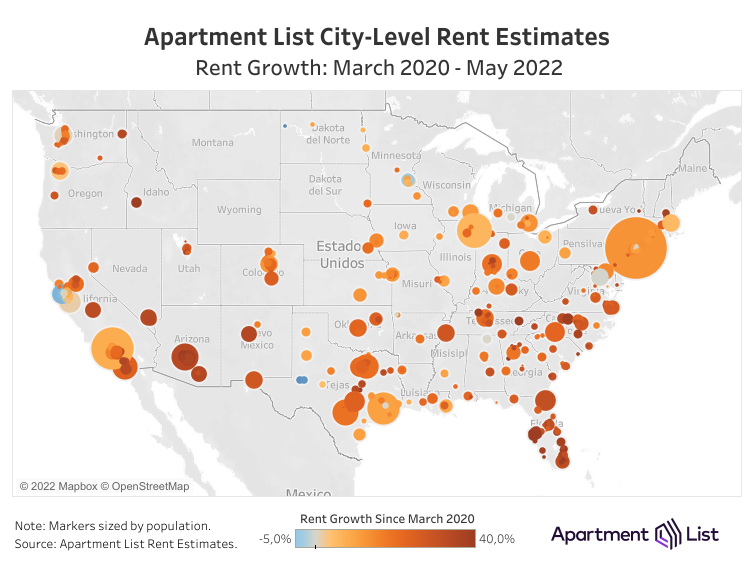
To learn more about the data behind this article and what Apartment List has to offer, visit https://www.apartmentlist.com/.







Sign up to receive our stories in your inbox.
Data is changing the speed of business. Investors, Corporations, and Governments are buying new, differentiated data to gain visibility make better decisions. Don't fall behind. Let us help.













Sign up to receive our stories in your inbox.
Data is changing the speed of business. Investors, Corporations, and Governments are buying new, differentiated data to gain visibility make better decisions. Don't fall behind. Let us help.





